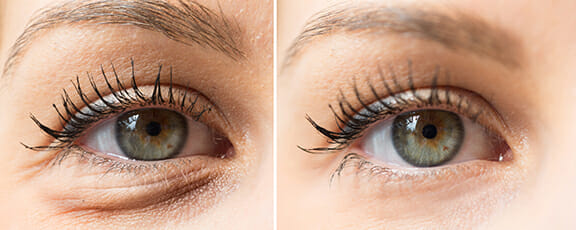What is eyelid surgery?
Eyelid surgery includes treatment of either or both the upper and lower eyelids to achieve cosmetic improvement, to improve vision or to gain other functional improvement as in the treatment of dry eyes with surgery. Less often, eyelid surgery is performed to treat skin cancer that can occur on the eyelids or to strengthen the lower eyelid that can become weakened with the aging process.
Both upper and lower eyelids can be treated to gain cosmetic improvement. Removal of excess skin of the upper lid creates a more youthful appearance by not only removing drooping tissues but also by creating a crisp lid fold within the upper lid. Even if upper lid surgery is being performed for cosmetic reasons only, patient usually report being able to see better and also say that they don’t feel their lids are as heavy as prior to their procedure. The upper lid skin removal is generally carried past the outside part of the eyelid and so improvements in the Crow’s foot area can be made.
Lower lid surgery (lower blepharoplasty) is performed with goals that include removal of excess folded skin and wrinkles and what patient commonly refer to as “fat bags” of the lower eyelid.
Patients have differing effects of the aging process on their lids, have different shapes and desires for their treatment and so the different types of eyelid surgery are customized for a particular patient’s needs in consultation with a facial plastic surgeon.
Does Eyelid Surgery Hurt?
Eyelid surgery is one of the least painful procedures performed by plastic surgeons. In fact, it’s pretty rare for patients to take narcotics after eyelid surgery. Patients may opt for laser treatment of the lower eyelids and Crow’s foot area as part of their eyelid surgery regime which can sting and burn for about 36 hours and is relieved with cool moist soaks. Significant pain is so rare that it might be a sign that patients are having a complication and need to call their plastic surgeon immediately.
Is Eyelid Surgery Dangerous?
When patients are thoroughly evaluated and chosen as good candidates for eyelid surgery, the surgery is very safe. However, when patients are taking aspirin products, have high blood pressure or are at risk of falling, the risk is much higher. Therefore, at consultation patients are instructed to avoid aspirin type medications (NSAIDS) before and after surgery and blood pressure is controlled or current medication adjusted. Patients who are at risk for falling are given assistance or the surgery is modified to improve the safety of the procedure.
Does eyelid surgery leave a scar?
There is a rule in Plastic surgery that the thinner the skin, the better the scar. Eyelid skin is the thinnest in the entire body and therefore generally makes the best and least visible scars. With regard to the lower eyelid, there is also the alternative to remove prominent fat from inside the eyelid which does not place a scar on the outside.
Is eyelid surgery done under anesthesia?
There are several types of anesthesia: local anesthesia, local anesthesia with oral sedation (pills), IV sedation (also called conscious sedation), monitored anesthesia care (when an anesthesiologist administers IV sedation) and general anesthesia. The choice of anesthesia for a particular patient depends on patient comfort, how the plastic surgeon can best accomplish the goals of the procedure, the patient’s medical issues, the duration of the procedure and whether other procedures will be combined with eyelid surgery.
Upper eyelid surgery alone is most often performed under local anesthesia with or without oral sedation in-office.
Can eyelid surgery affect vision?
Remember that upper lid skin removal (blepharoplasty) is being performed at least partly to improve vision. Otherwise, eyelid surgery can affect vision because about 10% of refraction (light bending) comes from the cornea itself and 90% from the lens. The lids can press on the cornea and so after eyelid surgery the lids can press differently on the cornea and thus change vision. This may require a change in the prescription of a patient’s glasses or contacts.
Can eyelid surgery make someone look better?
The majority of eyelid surgery in the United Sates is performed for cosmetic reasons. Upper and lower eyelid procedures not only make the lids appear younger and more refreshed, they also change the way that the eyelid area looks in conjunction with the face. That’s why it is important to see a plastic surgeon who can take the entire face into consideration and can also assess lid health and make the best recommendation for a particular patient. Some patients may require a brow lift to treat skin excess of the upper lid or need a special type of lower lid surgery that is customized to their anatomy and personal wishes.
Can eyelid surgery be covered by my insurance?
Lower eyelid surgery is never covered by insurance but upper eyelid surgery can be covered under certain circumstances. Generally, for insurance to cover upper eyelid surgery (blepharoplasty), documentation is required which include a photo showing that the upper lid covers at least part of the pupil and visual field studies that show poor vision in the upper visual fields. It depends a lot on what criteria your insurance carrier uses. The best course is to make a consultation with a plastic surgeon who can evaluate you and provide this necessary documentation for your insurance company.
Dr. David Newman is a board certified facial plastic surgeon. Want to find out if your doctor is board certified? Go to CertificationMatters.org.

